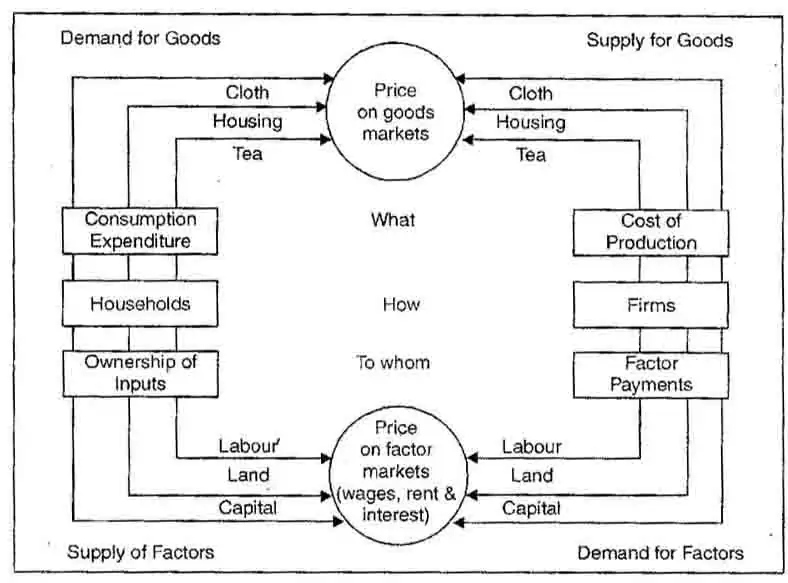What are the Limitations of Price Mechanism?
Limitations and defects of price mechanism:
The major limitations of the price mechanism are as follows:
The price mechanism is unable to cope with the supply of those goods or services where the benefit is diffuse or indiscriminate. These are goods such as defense or the services of the police force. These cannot be supplied by the market.
It is wrong to say that the price system leads to the production of goods which the consumers prefers the most. Rather, the consumer are hypnotized through high pressure salesmanship to buy goods which the producers think most profitable to produce. The consumer’s sovereignty is myth.
The price system accent rates economic inequalities.
The effectiveness of the price mechanism is reduced by the existence of various imperfections in the market.
The price system has proved to be an imperfect mechanism for achieving full employment.
The price system does not help the economy of the country or adjust quickly to drentic charges is community’s production targets.
The critics also point out that the price system fails to register all costs and benefits. It shows only the cost of the producers, but not the social courts.
Similarly, it only register utility of purchase to the individual consumer but takes no notice of the benefits to the society. The various limitation of the price mechanism call for some sort of government regulation and control over the working of the system.
Solution of economic problems created by price mechanism:
In a free market (or capitalist) economy. The price mechanism solves the central problems. The working of the price mechanism is really remarkable. No individual is consciously Concerned with the problems of what, how and for whom, and yet a capitalist economy solves the central problem of
- what to product,
- how to produce and
- for whom to produce, through its working.
The role of the price mechanism is solving the problems of what, how and for whom’ is explained below:-
What to produce?
The problem of what to produce, is determined by consumers preferences expressed freely in the market. This power of consumers to determine the allocation of resources in the production of different goods and services is called consumer. sovereignty.
The consumer is, so to say, a king, who decides what is to be, produced and in what quality by making his wishes known by the types and quantities of the goods he buys in the market. Thus, it is the demand of the consumers for a particular. Commodity that determines what commodity will be produced.
How to produce?
The decision of ‘how to produce’ is determined by competition among firms for the available factors of production (like labor and capital.). The prices of the factors of production are determined by demand and supply conditions. Profit maximizing firms can only achieve their objectives by keeping their cost of a minimum and making use of the most efficient methods of production.
In other words, producers will produce with the least cost combination of resources that is, with the most efficient technique of production. If labor is relatively cheaper than capital, labor intensive methods of production will be used.
For whom to produce?
The decision of “for whom to produce” or distribution of national product” is also determined by demand and supply conditions in factors markets (Which are markets for the factors of production and similar to the markets for good). Thus it is the price of the factors of production in the factor markets which determines the distribution of national output between the different factors.
These factors prices constitute the incomes of the owner’s of the factors. Households are considered as the owners of the factors. They provide factors of production to the firms, in lieu of that, they earn incomes.
The income of a household depends upon the wage rate it can earn by selling labor services. In perfect competition, the wage rate will depend on the demand for and the supply of labor. The goods and services produced get distributed between different households on the basis of their income, thus, it is the price mechanism (using demand and supply of the factors and their prices) which determines the distribution of incomes to the households and share of each individuals in the national output.
Diagrammatic Representation of the solution to the problems:
How the three problems are solved in a free capitalistic economy with the aid of price mechanism can also be explained with the help of a circular flow diagram as shown in figure below

The circular flow diagram depicted in figure is divided into two parts:
Households and Firms. Households own factor -inputs and supply factor services to the business firms through the factor markets. The households are paid for their services in the form of factor payments that firms make to them. The amount of factor payment is determined by the demand and supply of the respective factors. Similarly, goods are produced and supplied by the business firms to the households through the goods markets.
The households constitute the demand side of the goods market. The intersection of demand and supply determines the equilibrium price of the goods produced, and also determines the quantity of each of the goods produced. In short, the market forces of demand and supply operating in both the goods markets and the factor markets provide answer to the riddle : What, How and for Whom.
Government intervention for solving the problems:
Government intervention can altar market outcomes in the following two ways; whereby it can influence the price at which commodities are bought and sold.
It can change the equilibrium price this is done by the following ways:
- Disequilibrium trading
- Tax rebates concessions
- Subsidies
- Agriculture stabilization programmes
It can use the law and enact legislation that regulates the price. This is done by the following ways:
- Price controls & Rationing
- Supporting price
- Minimum wages act
- Rent control




